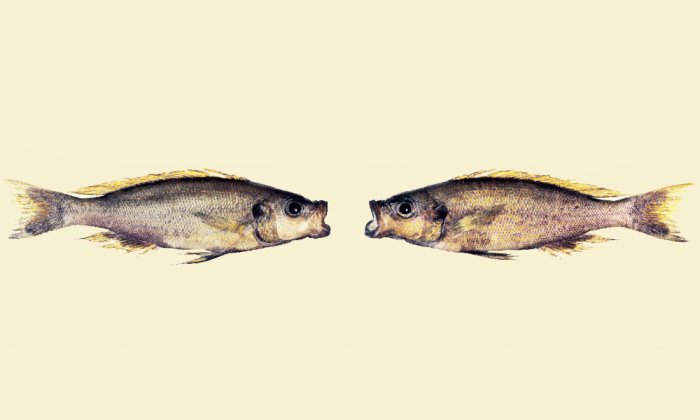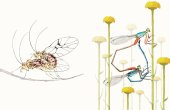Lessons From Lake Tanganyika’s Scale Eating Fish

Glance around any social event and it’s obvious that people, like all living things, vary in most any trait one can see or measure. And with our newfound ability to sequence entire genomes from thousands of species, we are learning that even more variation is hidden in our DNA. Working out how all this variation persists has been one of the great challenges of evolutionary biology.
So it’s refreshing and even surprising that in an age of automated DNA sequencing and artificial intelligence, important progress on this longstanding problem has been coming from careful field studies of a peculiar fish from a remote ancient lake.

Our story begins in 1954, on the shores of Lake Tanganyika in then Belgian Congo, with a little paper about fish diets titled “A Curious Ecological ‘Niche’ among the Fishes of Lake Tanganyika.”
The authors, biologists Georges Marlier and Narcisse Leleup, describe a little-studied species of cichlid fish. According to their findings, adults subsist mainly on the scales of other fish, which they tear off their living prey with fearsome teeth. Marlier and Leleup note that the individuals they held in an aquarium would not eat “earthworms, fish powder or insects” or anything else they presented other than the scales of live fish.
A few decades later, in one of the first studies to look carefully at evolution in this and several related species, the eminent Harvard fish biologist Karel Liem and his coauthor Donald Stewart investigated the mechanics of how these fish evolved to feed on scales, with a special focus on their jaws and teeth. They described a new species with notably extreme laterality (a particularly strong twisting of the head toward the left side or the right) and proposed that asymmetry in the shape of these fish’s skulls was associated with their macabre diets, likely providing an advantage in feeding. They also noted that there were similar numbers of right and left-twisted individuals.
The laboratory work provided important insights, but it was a long-term field study, appearing in 1993 in Science and led by Michio Hori, that began to explain the persistence of both left and right mouth laterality in Tanganyika’s scale eaters. For most of a decade, I presented the work described in this paper every time I taught a course in evolution to undergraduate biology students. It is quite literally a textbook study.
When Michio Hori towed a prey fish behind a boat and captured wild scale eaters after they struck it, individuals attacking from the right always had a mouth with a left twist.
Hori found that his study animal, Perissodus microlepis, typically attacks by striking the prey fish on the side of the body, approaching from the rear to be less visible. When he towed a prey fish behind a boat and captured wild scale eaters after they struck it, individuals attacking from the right always had a mouth with a left twist, whereas individuals attacking from the left always had a mouth that twisted right. He was also able to identify scales, from Perissodus stomachs, as having come from the left or right side of the prey based on their pore patterns. Much as with strike observations, fish with right-twisted mouths had eaten scales from the left side of their prey and left-twisted scale eaters had eaten scales from the right.
But why should the scale eater population show such exceptional variation, with the mouths of some individuals twisting visibly to the right and others to the left?
Hori’s answer — frequency dependence — and the evidence he collected to support it, are the reason the paper attracted enduring attention. Frequency dependence occurs when rare traits or strategies are more successful than common ones. It’s a principle nicely illustrated through sport.
When there are direct contests between individuals, a combatant/competitor can gain an advantage by having a strategy that is unfamiliar to opponents. For example, left-handed fencers, who are generally less common, will be familiar with the attacks and defenses of right-handed opponents, as right-handers are frequently encountered. But right-handers will have less experience of lefties — giving the rare left-handers an advantage. Consequently, lefties are at a higher frequency among competitive fencers than in the general population. The same goes for cricket, baseball, table tennis, and martial arts. In these highly interactive sports (and others), having the less common laterality — being a leftie — is advantageous. Success is frequency dependent, negatively so to be precise: as one’s frequency goes up, success goes down and as frequency goes down, success increases.
Hori hypothesized that scale eaters are a bit like fencers. If scale eaters always struck from one side, say, the right, their prey would only have to guard against predictable attacks from a single direction and could probably do so effectively. Any rare scale eater biting from the left should do particularly well in this situation, against unprepared prey. Of course, as lefties become more common, the prey should shift their attention accordingly. Thus the situation should lead to frequency dependence and the persistent presence of both left-and right-attacking scale eaters in the population, at something close to fifty-fifty.
Hori was able to test for frequency dependence by taking advantage of natural ups and downs in the relative abundance of fish with right-or left-twisted mouths. About every 2.5 years, the population shifted from mainly lefty fish to mainly fish with right-twisted mouths. By looking at scars on the sides of prey fish, Hori was able to estimate the relative success of the morph that was less common. He found that, as expected, whichever twist type was less abundant left more scars and achieved more successful bites, with success rates flipping when the rare morph’s frequency increased and it became the abundant variety.
Hori also inferred the genetic basis of mouth laterality from his fieldwork, suggesting that a single gene with two genetic variants could account for much of the variation in the direction of twisting, with right twisting dominant. Follow up studies in other laboratories have provided additional evidence that laterality is heritable to some degree, but not necessarily through a single gene for head shape. In contrast, the frequency dependence hypothesis has been supported unequivocally, by a bold study that is as elegantly designed as logistically difficult.
In 2018, researchers at the University of Basel conducted one of the very few manipulative field experiments that have been undertaken with a cichlid of the African Great Lakes. They placed a series of underwater enclosures at six to nine meters depth on the bottom of Lake Tanganyika. Each enclosure was stocked with prey fish and scale-eating cichlids, either all lefties, all right twists, or a fifty-fifty mixture of the two — but always the same total number of prey and scale eaters.
With attacks coming predictably from one side, the prey in all leftie or all right-twist enclosures, they expected, would be able to avoid the scale eaters better than with a mixture of right-and left-twisted Perissodus. By the same logic, the Perissodus scale eaters would experience the greatest feeding success in the mixed group — and this was indeed the case. By the end of the three-day experiment, prey fish housed with a mix of lefties and right-twisted scale eaters had lost more scales on average, and the scale eaters were more likely to have scales in their digestive tracts.
For the thousands of us cichlid enthusiasts scattered across every continent but Antarctica, these findings are intriguing simply because they reveal a little more about the intricacies of the lives of these beloved fish. But the work is of far broader interest and consequence.
First, the radiations (evolutionary biology’s term for diversifications) of cichlid fish in Africa’s Great Lakes of Tanganyika, Malawi and Victoria are the most extraordinary adaptive radiations of any vertebrate and also a pressing conservation priority. In each lake, one or a very few ancestors have rapidly diversified to yield from approximately 240 (Tanganyika) to 850 (Malawi) new species. Victoria, the youngest, is the most remarkable because it dried out almost completely, leaving little more than swamps, about 20,000 years ago. Since refilling a few thousand years later, approximately 500 species of cichlid have evolved in that very lake. These species made use of ancient genetic variation that persisted mainly in smalls sets of swamp-dwellers, as well as fish from the nearby Western rift valley, that hybridized, or interbred, to give rise to the current adaptive radiation.
Given the existing cichlid extinctions and the numerous human-caused pressures on these lakes, these insights are crucial for conservation.
The importance of hybridization in these radiations is one of the surprising results emerging from the African lakes and from studies of other ancient lake systems, but so is the importance of “standing genetic variation” within populations and species. Thus understanding processes that maintain genetic variation within a species, like frequency dependence, is also essential to understanding how the most rapid diversifications in any vertebrate have occurred. Given that there have already been many cichlid extinctions in one of the lakes, Victoria, and all of them are experiencing a nasty brew of human-caused stresses, these insights will likely be important for conservation too.
Discovering and investigating the processes responsible for the remarkable variation we are seeing as we sequence ever more genomes is also important for human health. A key reason organ transplants, for example, are notoriously difficult is because of the highly variable histocompatibility genes that our immune system uses to recognize potential threats. These have evolved through coevolutionary processes, much like the evolutionary tango of the scale eaters and their prey. Except in this case, it’s between us (the hosts) and the parasites that plague us.
Thus, our fates are linked to those of other creatures not only through our numerous ecological connections, but also by the evolutionary processes that shape the natural world and impact our lives in the most profound ways — processes that mediate both the frequencies of scale eating cichlids and whether a transplanted kidney will serve its new recipient for only a few difficult weeks or many healthy years.
Jeffrey McKinnon is a professor of biology at East Carolina University. His research has taken him to every continent but Antarctica and has appeared in journals including Nature and the American Naturalist. He is the author of “Our Ancient Lakes: A Natural History,” from which this article is adapted.



